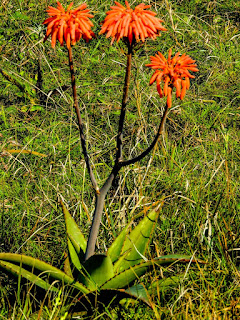Graham and Kate did not walk with the group this week -- Graham was recuperating after his altercation, while riding his bike,
with a male bushbuck and Kate stayed behind to prevent any ideas of getting
back on the bike. However, Mervyn has decided to re-join the group - a warm welcome back! Anne
contributed the following outing report.
Four of us set off from the offices at Beacon Hill up to the Beacon to
show Mervyn the commemorative plaque. He had previously scoured the
neighbouring koppie to no avail. After having savoured the view we clambered
down the steep side and then set off down to the dam on the stream we initially
thought was Mr. Nic’s Gully and which we have now named Nic II.
Along the way we passed Helichrysum populifolium, Tricalysia
capensis, Watsonia pillansii, Canthium van wykii. Moving away from the dam, we stumbled on the first Struthiola and
then they were everywhere in various stages of bud and flower. Tucked deeper
into the steep stream banks were Clivia robusta, Indigofera
natalensis. Robsonodendron eucleiforme and Pavetta bowkerii and
a really large Peddiea africana.
We puzzled awhile at a healthy stand of Leucadendron spissifolium subsp natalense
looking for signs of cones either old or new but found none.
After lunching on the warm rocks next to the Beacon Hill form of Syzygium cordatum we explored the stream bed to find Anastrabe integerrima,
Streptocarpus leaves but unfortunately no
flowers or fruit and, below a grand waterfall, a lovely swimming pool. Roll on
summer!
Further down the gully towards the drop off into the Bulolo we saw many
other old friends but very few in flower, Burchellia bubalina, an unidentified Ochna species,
Schefflera umbellifera, Bersama spp and the list goes on. For
dry looking veld a pretty good haul.
We curtailed our wanderings to have time for visits to Joan and Graham on the way home.
Participants: Anne S, Dorothy M, Mervyn T, Uschi T
























































